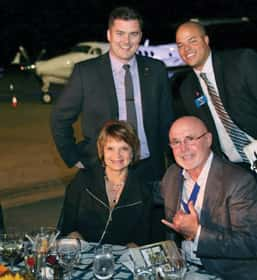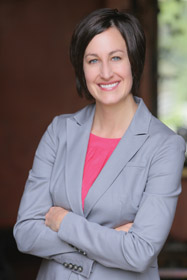Putting our money where our mouth is to support children
Whether helping with critical services and support, enrichment programs or education, there are a plethora of nonprofits in the North Bay that support children. And while there are many different types of organizations serving diverse demographics and executing varying missions, some working directly with children and some that are grant-giving organizations raising funds for nonprofits that support children, most deal with similar challenges—not much different than in the corporate world—such as funding, marketing and staffing.
While creating awareness of an entity can be a challenge (whether it’s a business or a nonprofit), grant-giving organizations have the added challenge of marketing something much more ambiguous than organizations serving one specific need or demographic.
 “We have a lot of nonprofits in this area and most of them are for one specific cause,” says Nate Friar, board member of the Active 20-30 Club of Santa Rosa #50, a group of community members (between the ages of 20 and 39) who volunteer to improve the lives of underprivileged youth in Santa Rosa through large-scale fund-raisers (such as the “Battle of the Brews” coming up in March) and direct philanthropic endeavors (such as Children’s Shopping Spree, where more than 200 kids are taken back-to-school shopping). “The 20-30 Club is very broad and, sometimes, it can be hard to market. You can have a nonprofit trying to raise money for themselves and a specific purpose. And then you have the 20-30 Club, which is trying to raise money to give to multiple charities. That’s one of our biggest challenges in getting the word out—we’re very broad and always trying to help new organizations.”
“We have a lot of nonprofits in this area and most of them are for one specific cause,” says Nate Friar, board member of the Active 20-30 Club of Santa Rosa #50, a group of community members (between the ages of 20 and 39) who volunteer to improve the lives of underprivileged youth in Santa Rosa through large-scale fund-raisers (such as the “Battle of the Brews” coming up in March) and direct philanthropic endeavors (such as Children’s Shopping Spree, where more than 200 kids are taken back-to-school shopping). “The 20-30 Club is very broad and, sometimes, it can be hard to market. You can have a nonprofit trying to raise money for themselves and a specific purpose. And then you have the 20-30 Club, which is trying to raise money to give to multiple charities. That’s one of our biggest challenges in getting the word out—we’re very broad and always trying to help new organizations.”Getting the job done
For organizations that give grants to the many deserving nonprofits working with children, much of the information on what a community needs comes from those who are on the front line, both service-minded individuals and altruistic organizations.
“Once we’re guided by the process of the community health needs assessment [a study Kaiser Permanente participates in every three years], we reach out to the community,” says Jeannie Dulberg, community benefit manager for Kaiser Permanente in Marin and Sonoma, which awarded 42 grants in 2014, totaling $540,000. “It’s usually a very good reflection of what services are necessary. We’re fortunate our nonprofits do such a good job of providing what the community needs.”
Ultimately, it takes a lot of partnership to make a community healthy. To that end, Kaiser Permanente collaborates with many organizations to extend the reach of Kaiser Permanente’s mission of improving the health of its members and the communities it serves, including children.
“This community benefit funding helps support organizations doing valuable work,” says Dulberg. “It’s a wonderful collaboration, knowing we’re partnering to help adults and children in our community be as healthy as they can be.”
 Greenbrae-based Marin Charitable, an all-volunteer, nonprofit organization that raises funds to support nonprofit organizations with programs serving school-aged children in Marin County, has a unique method for reviewing and accepting grant proposals. The organization’s grant committee, made up of approximately 20 volunteers, meets with each and every grant applicant (this year there were 63) to get a full understanding of their services, budget and operations. This helps committee members understand the needs in the community, build relationships and link organizations together that may be offering similar or complementary services so they can leverage each other’s strengths.
Greenbrae-based Marin Charitable, an all-volunteer, nonprofit organization that raises funds to support nonprofit organizations with programs serving school-aged children in Marin County, has a unique method for reviewing and accepting grant proposals. The organization’s grant committee, made up of approximately 20 volunteers, meets with each and every grant applicant (this year there were 63) to get a full understanding of their services, budget and operations. This helps committee members understand the needs in the community, build relationships and link organizations together that may be offering similar or complementary services so they can leverage each other’s strengths.“We have a lot of relationships that have been built over the years by going out and visiting organizations that support kids,” explains Jenny Potter, publicity chair for Marin Charitable. “We understand where they’re working, help them link together to create a better network for the underserved population. It helps us get a really good idea of where the needs are.”
It takes a village
While there can be considerable competition for funding dollars, sponsors and volunteers, most nonprofit organizations keep the greater good in mind and willingly work together to improve the well-being of underserved populations.
“The other hospitals in both Marin and Sonoma counties, along with the county health departments, all work together to try to address these [health] needs, and I think that’s a really important part of the work that community benefit departments do,” says Dulberg. “We work hard to have a collective impact. We meet regularly to discuss how we can best address the needs in our community. It’s a really wonderful part of the work that we get to do.”
A big challenge cited by several grant-giving organizations is the necessity to sometimes say “No” to an organization. The bottom line is that, even with more than $0.5 million awarded this year just from Kaiser Permanente, there are more requests for grants coming in than there is money to fund them. Of the 120 letters of intent the organization received, 42 received grants.
“My biggest challenge was not being able to fund all of the deserving organizations in our community,” says Dulberg. “There are so many nonprofit organizations doing really good work, and all are deserving of support.”
The good news is that, as our economy has improved over the last several years, so has giving to nonprofits—on an individual level, in participation and support of fund-raising events, in volunteerism and in corporate sponsorships. Anytime businesses do well, nonprofits do better, too.
 “We want people to make money. The more money people are making, the more money they’re going to give!” quips Mark Kuhnhausen, executive director of the Boys and Girls Clubs of Napa Valley, which serves 1,200 children every day at 11 sites throughout Napa Valley. “I don’t think we’ll ever get back to the height of philanthropy as it was in 2007, just because when you have such an economic plummet, people remember. I’ve noticed that some people who were very generous donors during that time aren’t giving as much as they did back then. It will take some time. They’re still giving, but with so much uncertainty in the world, they’re more cautious.”
“We want people to make money. The more money people are making, the more money they’re going to give!” quips Mark Kuhnhausen, executive director of the Boys and Girls Clubs of Napa Valley, which serves 1,200 children every day at 11 sites throughout Napa Valley. “I don’t think we’ll ever get back to the height of philanthropy as it was in 2007, just because when you have such an economic plummet, people remember. I’ve noticed that some people who were very generous donors during that time aren’t giving as much as they did back then. It will take some time. They’re still giving, but with so much uncertainty in the world, they’re more cautious.”Why businesses need to care
In addition to the obvious reasons for helping children on several levels—academically, with health initiatives and critical services, or simply recreation and personal growth—there’s also an economic boost to be gained from a region that puts children’s needs first. Simply giving them hope and encouragement can result in the confidence to do well in school and, ultimately, be productive and successful members of society.
As Kuhnhausen says, “No matter what circumstances you come from, everybody needs an additional caring adult. The more caring adults kids have in their lives, the better off they are.”
When a family is supported and children have their needs met, parents can be more productive at work, knowing their children are safe and sound. This can have a large economic benefit. In that regard, some organizations have evolved to include the children of those in need. For example, Women’s Recovery Services, a Santa Rosa-based organization that was founded to break the cycle of addiction for women in a safe residential setting, has become a solution for families broken by a mother’s addiction.
 “In the early 1980s, it became apparent that the program was restrictive because many women needing addiction treatment had children,” explains Cheryle Stanley, director of Women’s Recovery Services. “It’s common that, when addiction has reached the point that residential treatment is needed, families have become fractured, and there’s no one to watch infants and children while mothers come for treatment. Our mission brought the children’s needs to the forefront.”
“In the early 1980s, it became apparent that the program was restrictive because many women needing addiction treatment had children,” explains Cheryle Stanley, director of Women’s Recovery Services. “It’s common that, when addiction has reached the point that residential treatment is needed, families have become fractured, and there’s no one to watch infants and children while mothers come for treatment. Our mission brought the children’s needs to the forefront.”By meeting the needs of children of broken families (giving them a safe and supportive place to live and play, regular meals and facilitating them going to school everyday—sometimes a first) the mothers can focus on treatment and recovery. The family unit can be restored and the mothers learn the life skills necessary to become strong, responsible contributors in their communities.
“We find that much of society doesn’t feel the importance of caring for children, especially those from homes of poverty, homelessness and addiction,” says Stanley. “These children will be our future, whether they do well or not. Let’s make society a better place by raising less fortunate children to the same level as those who have more material goods.”
In addition, businesses that focus on meeting the needs of children through individual gifts of time and money help not only the nonprofits they support but themselves as well. It builds community, creates awareness and increases the overall well being of a region.
 “Something I’ve been very proud of is that we’ve had very consistent financial giving back to the community,” says Nicole Stein, vice president of community responsibility for Umpqua Bank, which implemented a $10 million charitable foundation in April 2014, above the already existing community giving program the bank has maintained. “That’s a lot to say when you look at those few years [of the economic downturn] that we held pretty steady and didn’t back off from the community. When we think of what makes a community bank, I think it’s the way you prioritize. We held steady during those years, and those are the years that our volunteerism actually grew substantially.”
“Something I’ve been very proud of is that we’ve had very consistent financial giving back to the community,” says Nicole Stein, vice president of community responsibility for Umpqua Bank, which implemented a $10 million charitable foundation in April 2014, above the already existing community giving program the bank has maintained. “That’s a lot to say when you look at those few years [of the economic downturn] that we held pretty steady and didn’t back off from the community. When we think of what makes a community bank, I think it’s the way you prioritize. We held steady during those years, and those are the years that our volunteerism actually grew substantially.”Nonprofits not only help those less fortunate, but help those who volunteer and participate as well.
“Not only do we help our community, we also build our members into leaders,” says Brandon Jewell, general member of the Active 20-30 Club of Santa Rosa. “When new members come in, we ask them to do a lot—basically let them get their feet wet and learn things that they haven’t done before, such as running committees and getting sponsorships. We help our members become better people and better leaders.”
Creating awareness
Because the North Bay is known as a wealthy area, nonprofits need to work harder to create basic awareness of the needs in this region. While the area has overall high statistics in the areas of median income, education and percentage of high school graduates, those same statistics don’t look as promising when they’re broken out into socioeconomic groups.
“The cost of living [in the Bay Area] can be outrageous,” explains Potter. “You have this group of people at the top who pay a lot for housing and who have good services and a lot of success with education. But for those people at the bottom, it’s that much further for them to go, because access to services can be so challenging. It’s so costly that those people [toward the bottom income brackets] can find themselves without access and in dire straits.”
With an overall robust and growing economy, housing prices picking up and unemployment dropping, many people in the community may not be aware of the needs for basic services a sizeable percentage of our population still has.
“Our biggest challenge is connecting our donors to the kids in need,” says Potter. “It’s hard for people to see outside of their own day-to-day sometimes and to see what’s going on in their broader county, city or neighborhood—the underserved we don’t see everyday. For us, an important piece is helping our community see there’s actually a big need despite the fact that Marin County has the highest per capita income in the nation. It’s a hard thing for some people to fathom.”
Where there’s a will
Despite the fact that there’s an abundance of North Bay nonprofits that are all competing for the same fund-raising dollars, volunteers, staff and market presence, there’s also a wealth of funding available.
“We want [NorthBay biz] readers to know we have an ongoing community-giving grant program,” says Stein. “We’d love to hear from folks in terms of what they have going on with their individual nonprofits and how they see it matching up with our goals.”
Because when those goals match up, everyone wins—the organization and its people, the donor, the children served, and the community and local economy as a whole.



